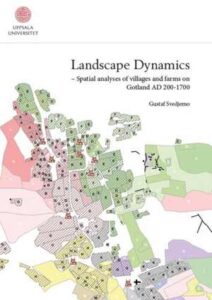نام کتاب: Landscape Dynamics – Spatial Analyses Of Villages And Farms On Gotland Ad 200-1700
نویسنده: Gustaf Svedjemo
ویرایش: ۱
سال انتشار: ۲۰۱۴
کد ISBN کتاب: ۹۱۵۰۶۲۳۸۵۰, ۹۷۸۹۱۵۰۶۲۳۸۵۷,
فرمت: PDF
تعداد صفحه: ۲۵۶
حجم کتاب: ۱۵ مگابایت
کیفیت کتاب: OCR
انتشارات: Uppsala University
Description About Book Landscape Dynamics – Spatial Analyses Of Villages And Farms On Gotland Ad 200-1700 From Amazon
This dissertation deals with the long-term dynamics and fluctuations of settlements on Gotland for the period from AD 200 up until early modern times. The settlement structure on Gotland is most often described as very stable and consisting of solitary farms, established in the Iron Age. A contrasting view is presented by analyses of a vast source material from different periods.
The source material consists of both physical remains, noted in the Swedish national Archaeological Sites Information System, FMIS and large scale historical maps, as well as other written sources. For the first studied period, the locations of some 2000 houses are known, since they were constructed with sturdy stone walls and are thus preserved. The source material for the following periods is scarcer, but some hundred Viking Age sites are identified, mainly by the find places of silver hoards. By retrogressive analyses of historical maps, from the decades around the year 1700, and other written sources, later periods are analysed. All available data are gathered in geodatabases, which enables both generalised and detailed spatial and statistical analyses.
The results of the analyses show a more varied picture, with great fluctuations in the number of farms; the existence of villages is also clearly indicated in a large part of the settlements. The villages are centred on kinship and the lack of strong royal power or landed gentry meant they were not fixed in cadastres, as fiscal units, as villages were on the Swedish mainland.
Two peaks, followed by major dips, were identified in the number of settlements and thus in the population. The first peak occurred during the late Roman Iron Age/Migration period, which was followed by a reduction in the Vendel period of possibly up to 30-50%. After this, a recovery started in the Viking Age, which culminated during the heydays of Gotland in the High Middle Ages, with population numbers most probably not surpassed until late in history. This upward trend was broken by the diminishing trade of Gotland, the Medieval agrarian crisis, The Danish invasion and later events. All this resulted in a decline, probably as great as after the Migration period.
درباره کتاب Landscape Dynamics – Spatial Analyses Of Villages And Farms On Gotland Ad 200-1700 ترجمه شده از گوگل
این پایان نامه به پویایی و نوسانات طولانی مدت شهرک های گوتلند برای دوره از ۲۰۰ میلادی تا اوایل دوران مدرن می پردازد. ساختار اسکان در گوتلند اغلب به عنوان بسیار پایدار توصیف می شود و متشکل از مزارع انفرادی است که در عصر آهن تأسیس شده است. یک دیدگاه متضاد با تجزیه و تحلیل یک ماده منبع گسترده از دوره های مختلف ارائه شده است.
مواد منبع شامل هر دو بقایای فیزیکی است که در سیستم اطلاعات ملی سایت های باستان شناسی سوئد ، نقشه های تاریخی FMIS و مقیاس بزرگ و همچنین منابع مکتوب دیگر ذکر شده است. برای اولین دوره مورد مطالعه ، محل حدود ۲۰۰۰ خانه شناخته شده است ، زیرا آنها با دیوارهای سنگی مقاوم ساخته شده اند و بنابراین حفظ می شوند. منبع اصلی دوره های بعدی کمیاب است ، اما حدود صد سایت عصر وایکینگ ها شناسایی می شود ، که عمدتا توسط مکان های یافتن انبارهای نقره است. با تجزیه و تحلیل بازگشتی از نقشه های تاریخی ، از دهه های حدود سال ۱۷۰۰ ، و سایر منابع مکتوب ، دوره های بعدی تجزیه و تحلیل می شود. تمام داده های موجود در پایگاه های داده ای جمع آوری شده است ، که تجزیه و تحلیل مکانی و آماری را به طور کلی و جزئی امکان پذیر می کند.
نتایج تجزیه و تحلیل ، تصویر متنوع تری را نشان می دهد که دارای نوسانات زیادی در تعداد مزارع است. وجود روستاها نیز در بخش بزرگی از سکونتگاهها به وضوح مشخص شده است. این دهکده ها با خویشاوندی متمرکز شده اند و فقدان قدرت سلطنتی قوی یا اعیانی مستقر به این معنی است که آنها به عنوان واحدهای مالی ، به عنوان دهکده ها در سرزمین اصلی سوئد در کاداسترها ثابت نشده اند.
دو قله و به دنبال آن هجوم عمده ، در تعداد سکونتگاه ها و در نتیجه در جمعیت شناسایی شد. اولین قله در اواخر دوره آهن / مهاجرت عصر آهن روم اتفاق افتاد ، که به دنبال آن کاهش دوره وندل احتمالاً تا ۳۰-۵۰ وجود داشت. پس از این ، بهبودی در عصر وایکینگ آغاز شد ، که در اوج شکوفایی گوتلند در قرون وسطی به اوج خود رسید ، به احتمال زیاد تا اواخر تاریخ از تعداد جمعیت فراتر نرفت. این روند صعودی با کاهش تجارت گوتلند ، بحران ارضی قرون وسطی ، حمله دانمارک و حوادث بعدی شکسته شد. همه اینها منجر به کاهش شد ، احتمالاً به اندازه بعد از مهاجرت.
[box type=”info”]![]() جهت دسترسی به توضیحات این کتاب در Amazon اینجا کلیک کنید.
جهت دسترسی به توضیحات این کتاب در Amazon اینجا کلیک کنید.![]() در صورت خراب بودن لینک کتاب، در قسمت نظرات همین مطلب گزارش دهید.
در صورت خراب بودن لینک کتاب، در قسمت نظرات همین مطلب گزارش دهید.

